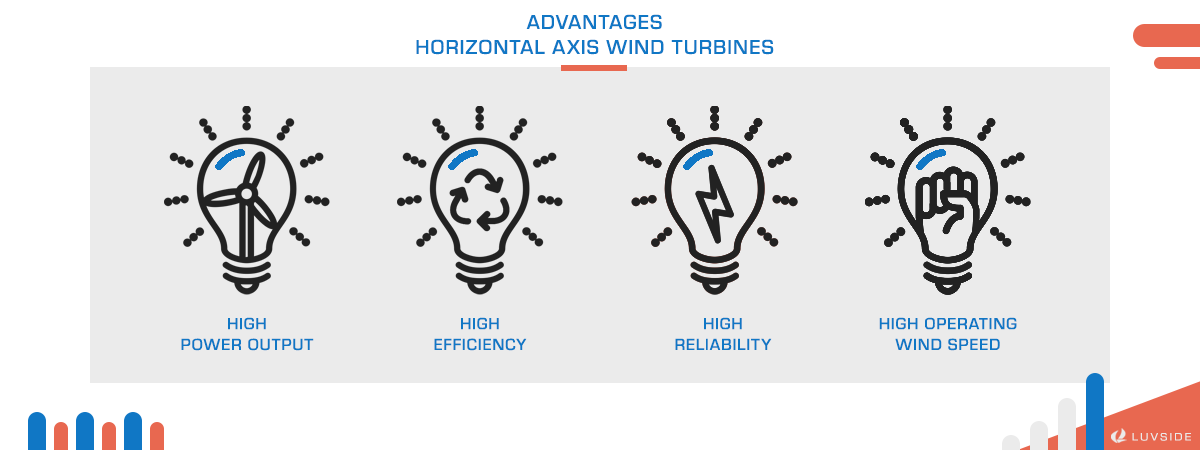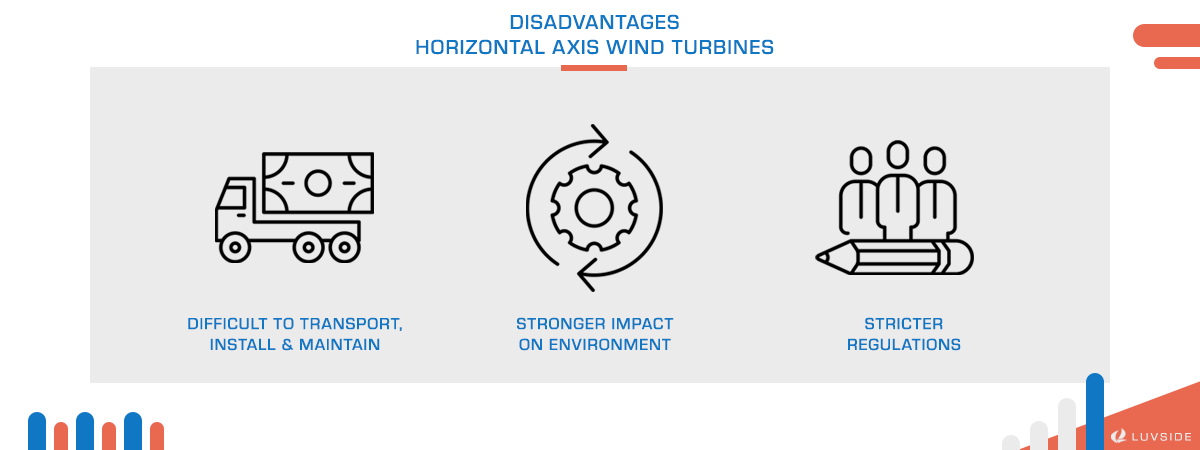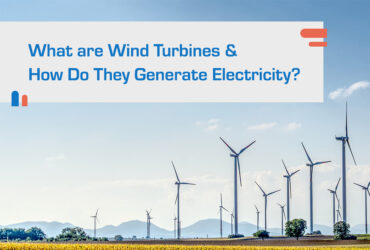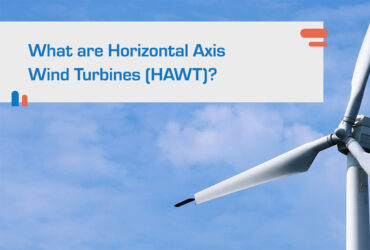
Horizontal wind turbines: advantages & disadvantages
Horizontal axis wind turbines are most often seen in large-scale wind farms for national projects or industrial plants, and here’s the reason why: Their advantages make them the perfect solution for mass electricity production. At the same time, their disadvantages require manpower, resources, and impeccable planning to tackle.

The 4 advantages of horizontal axis wind turbines
High Power Output
Horizontal axis wind turbines are generally built to have a capacity ranging between 2 to 8 MW, depending on the usage. While the output of a wind turbine depends on the turbine’s size and the wind speed, an average onshore wind turbine with a capacity of 2.5 – 3.0 MW can produce more than 6 million kWh in a year, which is enough to supply 1,500 average EU households with electricity.
High Efficiency
For any type of energy conversion, there is always energy lost. How to improve energy conversion efficiency is one of the biggest focuses of product development in the wind energy industry. Currently, horizontal axis wind turbines have the highest efficiency. They can transform 40 to 50 % of received wind power into electricity.
High Reliability
Being the dominant wind turbine model for decades, research and development of horizontal axis wind turbines are already mature. Not only are existing products on the market reliable, the application and usage of horizontal axis wind turbines are also thoroughly explored.
High Operational Wind Speed
Due to the height of the rotors, horizontal axis wind turbines are able to receive wind with greater speed. This means they are more likely to operate at higher wind speed which helps them provide optimal performance. Since the air flow at such height is relatively stable, horizontal axis wind turbines enjoy more consistency in wind and thus in power output.

The 3 disadvantages of horizontal axis wind turbines
Difficult to Transport, Install, and Maintain
Due to the sheer size of horizontal axis wind turbines, transporting and installing them come with great logistic and technical challenges. With blades sometimes as long as 70 meters and as heavy as 20 tons, horizontal axis wind turbines might just not fit onto the narrow, curvy roads of mountainous areas, or even our day-to-day roads where houses, utility poles, and street lamps line up the sides.
In 2015, CIMC Vehicles documented how they transported wind turbine blades through villages and forests, all the way up the Baoding Mountain in Yunnan Province, China.
Once the turbines are delivered, the challenge of installation comes. From ground foundation to electronics, component placement and assembly, it takes a whole team of professional workers and even months to install a turbine safely and properly. Orient Energy System documented the installation of their 50 MW wind farm in timelapse in 2018.
Last but not least, maintaining a horizontal axis wind turbine is especially consuming because the key components— the gearbox, generator, wind measuring systems, brake, yaw system, and rotor— are all located on the very top of the tower. This means maintenance experts have to carry out maintenance tasks at the dizzying height over 80 to 100 meters in high wind speed.
Create Negative Environmental Impact
The environmental impact of horizontal axis wind turbines are, until this day, still widely discussed and somewhat controversial. Concerns generally include the noise emission caused by enormous blades swooping across the air, the gigantic drop shadow, and the effect on wildlife and local ecosystems.
While the blades of horizontal axis wind turbines pose potential threats to collide with flying animals, offshore wind turbines are also likely to change the marine ecosystem in ways we do not know yet. On the other hand, a research published in the Journal of Applied Ecology led by ornithologists James W. Pearce‐Higgins in 2012 suggests that a large majority of species can coexist or thrive with wind farms once they are operating (Pearce-Higgins et al., 2012). Other statistical researches also conclude that in the United States, only 1% of birds killed annually by collisions with man-made structures and activities are directly linked to wind turbines.
Strict Regulations for Installation
Although governments around the world have established incentives to embark on renewable energy transformation, regulations for wind turbine development and installation can still become limitations. For example, the minimum distance to a neighboring household from a horizontal axis wind turbine is usually four times the turbine’s total height. Before installing a wind turbine in a certain area, the municipality must conduct a noise assessment to ensure limits are kept. This includes evaluating the existing noise as well as the new noise added by the wind turbine. While there is usually a general rule-of-thumb, policies can still vary based on different local political, social, and natural environments.
Related Content
Since centuries ago, humans have learned to utilize wind power for activities ranging from everyday tasks like grinding grains to long-distance traveling such as sailing....
Horizontal axis wind turbines are what most people picture when talking about wind turbines— the gigantic, white fans standing along the coastlines or across vast...

